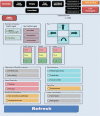The Relationship between Older Drivers' Performance on the Driving Observation Schedule (eDOS) and Cognitive Performance
- PMID: 24406947
- PMCID: PMC3861843
The Relationship between Older Drivers' Performance on the Driving Observation Schedule (eDOS) and Cognitive Performance
Abstract
Research question/objective: The Driving Observation Schedule (eDOS) was developed for use in the Candrive/Ozcandrive five-year prospective study of older drivers to observe the driving behavior of older drivers and monitor changes in driving behaviors over time. The aim of this study is to describe participants' driving performance during the eDOS driving task and investigate the association between driving performance and cognitive measures.
Methods: A subset of Ozcandrive participants (n = 144, 104 male [72%], 40 female [28%], Mean age = 81.49 years, SD = 3.58 years, Range: 76 - 96 years) completed the eDOS driving task. Participants drove to their selected destinations (up to 4 locations), with observations of driving behaviors (both inappropriate and appropriate) recorded for specific driving maneuvers: intersection negotiation, lane-changing, merging, low speed maneuvers and maneuver-free driving. Driving behaviors (e.g. signalling, speed regulation, gap acceptance, lane position, 'critical errors') were scored by a trained observer and participants received an overall eDOS driving task score (Maximum = 100 points). Participants also completed a series of cognitive assessments as part of the Year 2 Candrive/Ozcandrive assessment protocols.
Results: The overall eDOS driving task score was very high (M = 95.77; SD = 5.15; Range = 65.63 - 100). Detailed analyses of participants' driving behavior revealed a high level of appropriate driving behavior (96%, n = 5,935 maneuvers), with few errors (4%, n = 252 maneuvers). While most participants' performance on the cognitive assessments was high, some scores were below the criteria for cogntive impairment (BIC) according to conventional benchmarks: (MoCA: M = 26.56, SD = 2.12, Range = 19 - 30, % BIC = 28%; MMSE: M = 29.10, SD = 1.01, Range = 26-30, %BIC = 0%; Trails B: M = 111.66, SD = 43.53, Range = 50 - 301, %BIC = 6%). There was no significant relationship observed between participants' overall eDOS driving task scores and age (r (144) = -0.17, p > 0.05), and performance on various cognitive assessments including: MoCA (r (144) = 0.07, p > 0.1), MMSE (r (144) = 0.03, p > 0.5), Trail Making Test B (r (144) = 0.09, p > 0.1).
Implications: Preliminary analyses of the eDOS driving task revealed a high level of appropriate driving behavior among Ozcandrive older drivers. Despite some participants' cognitive performance suggesting impairment, participants' overall eDOS driving task scores were not significantly related to cognitive performance. This finding is consistent with previous research suggesting some older drivers are able to compensate well for age-related cognitive impairment.
Similar articles
-
Examining physiological responses across different driving maneuvers during an on-road driving task: a pilot study comparing older and younger drivers.Traffic Inj Prev. 2015;16:225-33. doi: 10.1080/15389588.2014.933478. Epub 2014 Nov 17. Traffic Inj Prev. 2015. PMID: 24949653
-
Development and evaluation of a driving observation schedule (DOS) to study everyday driving performance of older drivers.Accid Anal Prev. 2013 Dec;61:253-60. doi: 10.1016/j.aap.2013.03.027. Epub 2013 Apr 9. Accid Anal Prev. 2013. PMID: 23639887
-
Driving Task: How Older Drivers' On-Road Driving Performance Relates to Abilities, Perceptions, and Restrictions.Can J Aging. 2016 Jun;35 Suppl 1:15-31. doi: 10.1017/S0714980816000015. Epub 2016 Mar 29. Can J Aging. 2016. PMID: 27021591
-
Development of a weighted scoring system for the Electronic Driving Observation Schedule (eDOS).MethodsX. 2020 Oct 12;7:101099. doi: 10.1016/j.mex.2020.101099. eCollection 2020. MethodsX. 2020. PMID: 33224736 Free PMC article.
-
Are older drivers' driving patterns during an on-road driving task representative of their real-world driving patterns?Traffic Inj Prev. 2018;19(sup2):S173-S175. doi: 10.1080/15389588.2018.1532219. Traffic Inj Prev. 2018. PMID: 30841798
Cited by
-
Spatial Mental Transformation Skills Discriminate Fitness to Drive in Young and Old Adults.Front Psychol. 2020 Dec 3;11:604762. doi: 10.3389/fpsyg.2020.604762. eCollection 2020. Front Psychol. 2020. PMID: 33343475 Free PMC article.
-
Functional Changes and Driving Performance in Older Drivers: Assessment and Interventions.Geriatrics (Basel). 2016 May 20;1(2):12. doi: 10.3390/geriatrics1020012. Geriatrics (Basel). 2016. PMID: 31022806 Free PMC article. Review.
-
Are There Any Differences in Road Traffic Injury Outcomes between Older and Younger Adults? Setting the Grounds for Posttraumatic Senior Personal Injury Assessment Guidelines.J Clin Med. 2023 Mar 17;12(6):2353. doi: 10.3390/jcm12062353. J Clin Med. 2023. PMID: 36983355 Free PMC article.
-
Driving evaluation methods for able-bodied persons and individuals with lower extremity disabilities: a review of assessment modalities.Clinics (Sao Paulo). 2015 Sep;70(9):638-47. doi: 10.6061/clinics/2015(09)08. Clinics (Sao Paulo). 2015. PMID: 26375567 Free PMC article. Review.
-
Clinical Utility of the Trail-Making Test as a Predictor of Driving Performance in Older Adults.J Am Geriatr Soc. 2015 Nov;63(11):2358-64. doi: 10.1111/jgs.13776. Epub 2015 Oct 27. J Am Geriatr Soc. 2015. PMID: 26503623 Free PMC article.
References
-
- Anstey KJ, Wood J, Lord S, Walker JG. Cognitive, sensory and physical factors enabling driving safety in older adults. Clinical Psychology Review. 2004;25:45–65. - PubMed
-
- Augenstein J. Differences in clinical response between the young and the elderly. Paper presented at the Aging and Driving Symposium, Association for the Advancement of Automotive Medicine; Des Plaines, IL. 2001.
-
- Austroads . Medical standards for licensing and clinical management guidelines. A resource for health professionals in Australia. Sydney, Australia: 2006. Assessing fitness to drive for commercial and private vehicle drivers.
-
- Baldock MRJ, Mathias J, McLean J, Berndt A. Self-Regulation of Driving and Older Drivers’ Functional Abilities. Clinical Gerontologist. 2006;30:53–70.
-
- Ball KK, Roenker DL, Wadley VG, Edwards JD, Roth DL, McGwin G, Jr, Raleigh R, Joyce JJ, Cissell GM, Dube T. Can high-risk older drivers be identified through performance-based measures in a Department of Motor Vehicles setting? Journal of American Geriatric Society. 2006;54:77–84. - PubMed
LinkOut - more resources
Full Text Sources
Miscellaneous

